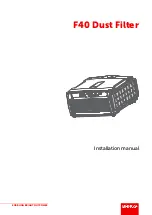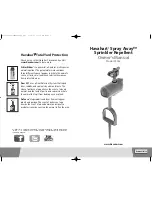
TFP621
Page 7 of 8
Installation
The TYCO Model CWS Specific
Application Window Sprinkler must
be installed in accordance with this
section.
General Instructions
A leak-tight 1/2 in. NPT sprinkler joint
should be obtained by applying a min-
imum-to-maximum torque of 7 to 14
lb-ft (9,5 to 19,0 N∙m). Higher levels of
torque may distort the sprinkler inlet
with consequent leakage or impairment
of the sprinkler.
Do not attempt to compensate for
insufficient adjustment in the Sprinkler
by under- or over-tightening the Sprin-
kler/Support Cup Assembly. Re-adjust
the position of the sprinkler fitting to
suit.
Step 1.
Install the Model CWS Window
Sprinkler only in the pendent position
with the center-line of the sprinkler
parallel to the glass surface. Orient the
sprinkler so that the direction of flow
indicated on the sprinkler deflector is
facing the window.
Step 2.
Remove the Protective Cap.
Step 3.
With pipe thread sealant
applied to the pipe threads, and using
the W-Type 39 Wrench, as shown in
Figure 3, install and tighten the Sprin-
kler/Support Cup Assembly into the
fitting. The W-Type 39 Wrench will
accept a 1/2 in. ratchet drive.
Step 4.
Replace the Protective Cap by
pushing it upwards until it bottoms
out against the Support Cup
(see Figure 2). The Protective Cap
helps prevent damage to the Deflector
and Guide Pin Housing during ceiling
installation and/or finish. You can also
use the Protective Cap to locate the
center of the clearance hole by gently
pushing the ceiling material up against
the center point of the Protective Cap.
NOTICE
As long as the Protective Cap remains
in place, the system is considered “Out
of Service”.
Step 5.
After the ceiling has been
completed with the 2 1/2 in. (63,5 mm)
diameter clearance hole and in prep-
aration for installing the Cover Plate/
Retainer Assembly, remove and
discard the Protective Cap. Verify that
the Deflector moves up and down
freely. If the Sprinkler is damaged and
the Deflector does not move up and
down freely, replace the entire Sprin-
kler. Do not attempt to modify or repair
a damaged sprinkler.
Step 6.
Push on the Cover Plate
Assembly until its flange comes in
contact with the ceiling.
Do not continue to push on the Cover
Plate Assembly such that it lifts a
ceiling panel out of its normal position.
If the Cover Plate Assembly cannot
be engaged with the Mounting Cup
or the Cover Plate Assembly cannot
be engaged sufficiently to contact the
ceiling, the Sprinkler Fitting must be
repositioned.
Care and
Maintenance
The TYCO Model CWS Specific Appli-
cation Window Sprinkler must be main-
tained and serviced in accordance with
this section.
Before closing a fire protection system
main control valve for maintenance
work on the fire protection system
that it controls, obtain permission to
shut down the affected fire protection
systems from the proper authorities
and notify all personnel who may be
affected by this action.
Absence of the Cover Plate Assem-
bly may delay sprinkler operation in a
fire situation. When properly installed,
there is a nominal 3/32 in. (2,4 mm) air
gap between the lip of the Cover Plate
and the ceiling, as shown in Figure 2.
This air gap is necessary for proper
operation of the sprinkler. If the ceiling
is to be repainted after the installation
of the Sprinkler, care must be exercised
to ensure that the new paint does not
seal off any of the air gap.
Factory painted Cover Plates must not
be repainted. They should be replaced,
if necessary, by factory painted
units. Non-factory applied paint may
adversely delay or prevent sprinkler
operation in the event of a fire.
Do not pull the Cover Plate relative to
the Enclosure. Separation may result.
Sprinklers which are found to be
leaking or exhibiting visible signs of
corrosion must be replaced.
Automatic sprinklers must never be
painted, plated, coated, or other-
wise altered after leaving the factory.
Modified sprinklers must be replaced.
Sprinklers that have been exposed to
corrosive products of combustion, but
have not operated, should be replaced
if they cannot be completely cleaned
by wiping the sprinkler with a cloth or
by brushing it with a soft bristle brush.
Care must be exercised to avoid
damage to the sprinklers before,
during, and after installation. Sprinklers
damaged by dropping, striking, wrench
twist/slippage, or the like, must be
replaced. See the Installation section
for additional information.
The owner is responsible for the
inspection, testing, and maintenance
of their fire protection system and
devices in compliance with this doc-
ument, as well as with the applicable
standards recognized by the Approval
agency, such as NFPA 25, in addition
to the standards of any authorities
having jurisdiction. Contact the install-
ing contractor or product manufacturer
regarding any questions.
Automatic sprinkler systems are rec-
ommended to be inspected, tested,
and maintained by a qualified Inspec-
tion Service in accordance with local
requirements and/or national codes.


























